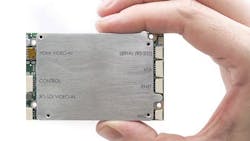Semiconductor Strategies Boost Domestic Supplies
Concern over defense-related electronic supply chains and reliance on offshore semiconductors has motivated the U.S. Department of Defense (DoD) to encourage investments in electronics technologies—especially semiconductors—within domestic shores.
The bipartisan Creating Helpful Incentives to Produce Semiconductors for America (CHIPS) and Science Act recently signed into law provides a clear roadmap for the revitalization of domestic electronics and semiconductor technologies and manufacturing capabilities. Leading semiconductor suppliers such as Micron Technology and Qualcomm have already announced their intentions to invest in new semiconductor manufacturing foundries within the U.S.
The $54.2 billion CHIPS and Science Act is designed to encourage electronics companies and semiconductor developers to keep foundries within U.S. shores, although not just for defense applications. Many of the semiconductors and related technologies are useful for electronic warfare (EW) and radar systems as well as commercial communications and wireless sensors such as Internet of Things (IoT) devices.
With frequency spectrum congested at lower frequencies but widely available at higher frequencies, recent interest among semiconductor developers includes transceivers operating at mmWave frequencies of 24 GHz and higher that also can support systems for 5G cellular wireless-communications networks.
Regarding the DoD’s investment in semiconductors and computing technologies, U.S. Secretary of Defense Lloyd J. Austin III noted, “The Department will continue to invest in programs to secure U. S. microelectronics interests, reverse the erosion of domestic innovation and supply, and establish a strong foundation for the next generation of microelectronics technology for DoD applications, while also sustaining current systems.”
While supporting efforts from the National Science Foundation (NSF), the CHIPS and Science Act is meant to restore onshore manufacturing of semiconductors and other electronic components, such as microprocessors, while strengthening component supply chains and reducing costs. Fabless semiconductor supplier Qualcomm recently announced a partnership with foundry GlobalFoundries whereby $4.2 billion will be invested to fabricate devices in a foundry in upstate New York.
About the Author
Jack Browne
Technical Contributor
Jack Browne, Technical Contributor, has worked in technical publishing for over 30 years. He managed the content and production of three technical journals while at the American Institute of Physics, including Medical Physics and the Journal of Vacuum Science & Technology. He has been a Publisher and Editor for Penton Media, started the firm’s Wireless Symposium & Exhibition trade show in 1993, and currently serves as Technical Contributor for that company's Microwaves & RF magazine. Browne, who holds a BS in Mathematics from City College of New York and BA degrees in English and Philosophy from Fordham University, is a member of the IEEE.
